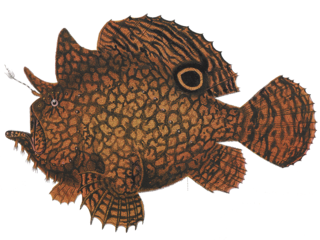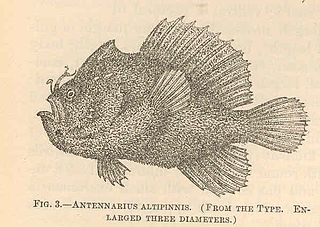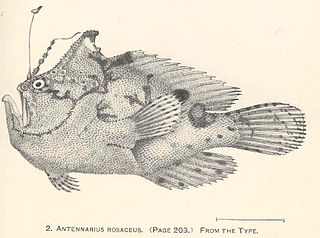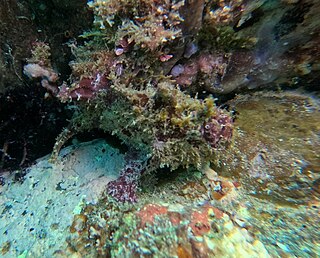
Frogfishes are any member of the anglerfish family Antennariidae, of the order Lophiiformes. Antennariids are known as anglerfish in Australia, where the term "frogfish" refers to members of the unrelated family Batrachoididae. Frogfishes are found in almost all tropical and subtropical oceans and seas around the world, the primary exception being the Mediterranean Sea.

The striated frogfish or hairy frogfish is a species of marine ray-finned fish belonging to the family Antennariidae, the frogfishes. This species is found in the Indo-Pacific and eastern Atlantic Ocean.

The warty frogfish or clown frogfish is a species of marine ray-finned fish belonging to the family Antennariidae, the frogfishes. The warty frogfish is found in the Indo-Pacific region.

Histiophryne is a genus of marine ray-finned fishes belonging to the subfamily Histiophryninae in the family Antennariidae, the frogfishes. These fishes are found in waters ranging from Taiwan to South Australia. There are currently five known species. These fishes are easily distinguished from other anglerfishes as having a reduced luring appendage, a highly evolved form of the first dorsal fin spine.

Fowlerichthys radiosus, the singlespot frogfish or big-eyed frogfish, is a species of marine ray-finned fish belonging to the family Antennariidae, the frogfishes. This fish is found in the Western Atlantic Ocean.

Antennarius is a genus of anglerfish belonging to the family Antennariidae, the frogfishes. The fishes in this genus are found in warmer parts of the Atlantic, Indian and Pacific Oceans.

Nudiantennarius is a monospecific genus of marine ray-finned fish belonging to the family Antennariidae, the frogfishes. The only species in the genus is Nudiantennarius subteres, the deepwater frogfish. This fish is found in the Western Pacific Ocean.

The shaggy frogfish, also known as the hispid frogfish, shaggy anglerfish or zebra anglerfish, is a marine ray-finned fish belonging to the family Antennariidae, the frogfishes. This fish is found in the Indo-Pacific.

The painted frogfish, or spotted frogfish, black angler or painted anglerfish is a species of marine ray-finned fish belonging to the family Antennariidae, the frogfishes. This species is found in the Indo-Pacific region.

Abantennarius sanguineus, the bloody frogfish or sanguine frogfish, is a species of marine ray-finned fish belonging to the family Antennariidae, the frogfishes. The sanguine frogfish is found in the eastern Pacific Ocean.

Randall's frogfish is a species of marine ray-finned fish belonging to the family Antennariidae, the frogfishes. This species is found in the Indo-Pacific region.

Antennarius biocellatus, the brackish water frogfish, brackish water anglerfish, freshwater frogfishtwinspot frogfish or fishing frog, is a species of euryhaline ray-finned fish belonging to the family Antennariidae, the frogfishes. This fish is found in the Western Pacific Ocean.

Antennarius indicus, the Indian frogfish, is a species of marine ray-finned fish belonging to the family Antennariidae, the frogfishes. The Indian frogfish is found in the Indian Ocean.

Antennarius pardalis, the leopard frogfish or peixe pescador, is a species of marine ray-finned fish belonging to the family Antennariidae, the frogfishes. This species is found in the eastern Atlantic Ocean.

Antennarius pauciradiatus, the dwarf frogfish or smallspot frogfish, is a species of marine ray-finned fish belonging to the family Antennariidae, the frogfishes. This species is found in the western Atlantic.
Abantennarius bermudensis, the island frogfish, is a species of marine ray-finned fish belonging to the family Antennariidae, the frogfishes. The island frogfish is found in the Western Atlantic Ocean.

Abantennarius dorehensis, the New Guinean frogfish, bandtail frogfish, Dorei frogfish or white-spotted frogfish, is a species of marine ray-finned fish belonging to the family Antennariidae, the frogfishes. The New Guinean frogfish is found in the Indo-Pacific region.

Abantennarius rosaceus, the rosy frogfish, rosy anglerfish, pink anglerfish or spiny tufted frogfish, is a species of marine ray-finned fish belonging to the family Antennariidae, the frogfishes. The rosy frogfish is found in the Indo-Pacific region.

Fowlerichthys avalonis, the roughbar frogfish or roughjaw frogfish, is a species of marine ray-finned fish belonging to the family Antennariidae, the frogfishes. This fish is found in the Eastern Pacific Ocean, where it is the most widespread frogfish species.

Antennarius scaber, the splitlure frogfish or striated frogfish, is a species of marine ray-finned fish belonging to the family Antennariidae, the frogfishes. This species is found in the Western Atlantic Ocean and was previously considered to be a synonym of Antennarius striatus.





















